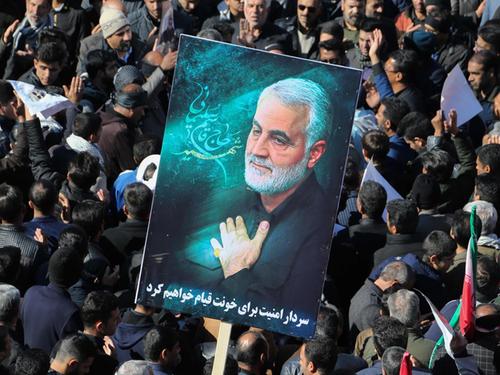The General’s Death Upsets Iran’s Plan
Amir Taheri/Asharq Al-Awsat/January 12/2020
رحيل سليماني وارتباك المخططات الإيرانية
أمير طاهري/الشرق الأوسط/12 كانون الثاني/2020
في الوقت الذي تتزاحم فيه تكهنات المحللين وصناع السياسات بشأن التدابير التي ربما تتخذها حكومة الملالي الإيرانية أخذاً بثأر قتيلهم العزيز على قلوبهم، فإن التساؤل الحقيقي الأولي بمزيد من التفكير يكمن في زاوية قَصِيّةٍ تماماً. والتساؤل هو: ما تداعيات مقتل سليماني على صراع السلطة المحتدم داخل أروقة الحكم والسياسة في طهران، وهو الأمر الذي من المؤكد أن تُستأنف مجرياته وفعالياته بصورة أكثر اشتعالاً في الآونة المقبلة داخل إيران؟ تحاول ماكينات الدعاية والإعلام الإيرانية الموجهة تسويق صورة سليماني على أنه الرجل ذو القدرات الخارقة الذي – وبمفرده – قد تمكن من سحب العراق وسوريا ولبنان وغزة وبضعة أجزاء من أفغانستان مع اليمن تحت العباءة الإيرانية المهيبة، مع نجاحه الباهر منقطع النظير في طرد الأميركيين مهرولين خارج حدود الشرق الأوسط الكبير، فضلاً عن سحقه القوي الشديد لخلافة «داعش» المزعومة التي تجرأت في محاولة منابزة الجمهورية الإسلامية الفتية في طهران! ولم يدّخر سليماني نفسه جهداً ولا طاقة في الترويج لنفسه ولتعزيز تلك الصورة في مخيلة مريديه، متلقياً إثر ذلك كثيراً من الزخم الإعلامي الغربي، لا سيما من الولايات المتحدة، ومن إسرائيل، التي اعتمدت في طرحها الإعلامي عن الرجل على ما عرضته طهران وإعلامها من بضاعة مزجاة.
بيد أن حقائق الواقع تطرح، رغم ذلك، صورة مغايرة تماماً عن الجنرال الإيراني الراحل. انضم قاسم سليماني إلى صفوف الثورة الإسلامية الإيرانية بدءاً من عام 1980 وكان عمره وقتذاك لا يجاوز 27 عاماً، في وقت كان فيه ملالي إيران منشغلين تماماً بتشكيل كتائب وألوية «الحرس الثوري» الجديد المعني بالحماية والدفاع عن ثورتهم الناشئة ونظام الحكم الوليد. وبعد ذلك ببضعة أشهر قليلة، تحرك جيش الدهماء المهلهل، الذي كان سليماني من جنوده الحدثاء، في مهمة مساندة الجيش الإيراني النظامي الذي تمزقت أوصاله في قتال القوات العراقية الغازية على حدود البلاد الغربية. وضمن 8 آلاف من الضباط وصف الضباط من مقاتلي الجيش الإيراني الوطني الذين زج بهم الخميني في تلك الحرب الضروس، تهيأت أولى فرص التسلق السريع لأشخاص على شاكلة قاسم سليماني، الذين انخرطوا في صفوف الجيش من دون تدريب أو تأهيل مناسب مع الطفيف من التعليم الرسمي وربما من دونه على الإطلاق. ومن ثم، وفي غضون ثلاث سنوات فحسب منذ انضمامه لصفوف «الحرس الثوري» الجديد، وجد الشاب اليافع سليماني نفسه قائداً لفرقة من المجندين الجدد. وكابدت القوات الإيرانية تحت قيادته ثلاثاً من أكبر الهزائم العسكرية المهينة في عمليات حملت أسماء «الفجر الثامن»، و«كربلاء الأولى»، و«كربلاء الثانية»، على التوالي. ويصف محسن رضائي، قائد «الحرس الثوري» الإيراني آنذاك، المعارك المزرية الثلاث بأنها سلسلة من الكوارث العسكرية الشديدة التي شهدتها القوات الإيرانية في تلك الحرب.
ومع ذلك، فإن قاسم سليماني، الذي كان معنياً قبل كل شيء بمواصلة إظهار عبقريته الفذة وقدراته الذاتية الخارقة، سجل فوزاً نوعياً – وربما مستداماً – عندما ألحق نفسه بحاشية الملا علي خامنئي، الذي كانت دلائل الأمر الواقع تشير إلى توليه منصب المرشد الإيراني الأعلى في الجمهورية الإسلامية.
وبدأ خامنئي حياته السياسية في منصب نائب وزير دفاع الجمهورية الإسلامية، وارتقى الدرجات سريعاً ليجري ترشيحه لتولي منصب رئيس الجمهورية الإسلامية، في حين أن قاسم سليماني، الذي لطالما وصفه نقّاده بـ«حامل حقيبة الملا»، لم يكن يُشاهد إلا بجانب علي خامنئي أينما حلّ أو ارتحل. وبحلول تسعينات القرن الماضي؛ أي في الآونة التي مهد فيها خامنئي الأجواء لنفسه على أنه صاحب الكلمة الوحيدة في تقرير مصير الأمة الإيرانية، اغتنم الداهية سليماني كل الفرص السانحة لتأمين موطئ قدم راسخة ضمن الزمرة الخامنئية الجديدة.
وجاء دور سليماني البارز المنتظر إثر صياغة مشروع جديد معني بتصدير الثورة الإيرانية الإسلامية إلى بلدان إسلامية أخرى. وبادئ ذي بدء، ولشرعنة المشروع الإيراني الجديد، جرى اعتبار تصدير الثورة الإسلامية أحد الواجبات الدينية المقدسة المنصوص عليها صراحة في دستور النظام الإيراني. ومع إيلاء أهمية قصوى للدعاية وإعادة تنظيم صفوف المتعاطفين مع الثورة الإسلامية في مختلف البلدان العربية المجاورة من خلال تنظيم جديد يحمل اسم «حزب الله»، أوكلت تلك المهمة إلى مكتب خاص ضمن دهاليز الخارجية الإيرانية تحت رئاسة آية الله هادي خسروشاهين. وإثر الضغوط المركزة التي مارسها سليماني جرى نقل التكليف بالمهمة من وزارة الخارجية إلى صفوف «الحرس الثوري» الإسلامي. ولكن حتى ذلك الوقت، لم يتمكن سليماني من حيازة المنصب الرفيع الذي كان يتوق إليه، وإنما تولاه العقيد إسماعيل قاآني، وهو الرجل الذي يخلف قاسم سليماني الآن على قيادة «فيلق القدس» في «الحرس الثوري». فكانت الخطوة التالية اللازمة من جانب سليماني تتمثل في إزاحة إسماعيل قاآني عن الصورة وتأمين المنصب الرفيع لنفسه، ليتولى العقيد قاآني منصب نائب القائد منذ ذلك الحين! وحتى هذه الخطوة لم تكن لترضي نهم سليماني المطلق للسلطة والنفوذ، الذي كانت «تعشش» في مخيلته أحلام طموحات كبرى. وبما أنه كان عضواً بارزاً ذا سطوة ضمن تراتب السلطة والقيادة في صفوف «الحرس الثوري» الإسلامي، فقد تعين عليه، رغم ذلك، طاعة أوامر كبار القادة الذين كان يزدريهم أيما ازدراء.
وبفضل دعم علي خامنئي وتأييده له، تمكن سليماني من تأمين إقطاعية سلطوية لنفسه تمثلت في «فيلق القدس» الذي – رغم أنه جزء لا يتجزأ من قيادة «الحرس الثوري» الإيراني – استقل بميزانيته الخاصة، وتراتبه القيادي الخاص، ولا يتلقى قائده أوامره إلا من قبل المرشد شخصياً دون غيره.
وبعد ذلك، انتقل سليماني إلى بسط سيطرته على سياسات طهران الخارجية فيما يتعلق بملفات ذات أهمية قصوى: البلدان العربية، وأفغانستان، وكوريا الشمالية، وأميركا الجنوبية، وكذلك روسيا، فيما يتصل ببعض الزوايا السياسية ذات الحساسية. ومنذ ذلك الحين، لم يسبق لأي من رؤساء الجمهورية الإسلامية ولا وزراء خارجيتها أن تمكنوا من إجراء محادثات مباشرة مع الرئيس الروسي فلاديمير بوتين، كمثل ما كان يفعل قاسم سليماني. وصار من المعتاد لدى قاسم سليماني أن يدلي برأيه النافذ في اختيار سفراء الجمهورية الإسلامية إلى عواصم عربية ذات أهمية مثل بغداد، ودمشق، وبيروت، والدوحة، وغيرها من العواصم العربية الأخرى. وجاء عرض دراماتيكي باهر لمدى الاستقلال والنفوذ الواسع الذي يملكه قاسم سليماني في إيران عندما سمح بدخول الرئيس السوري بشار الأسد إلى العاصمة طهران على متن طائرة خاصة من دون مجرد إبلاغ الحكومة الإيرانية أو رئيسها حسن روحاني ناهيكم بوزير خارجيتها الذي لم يكن من بين الحاضرين حال لقاء الرئيس السوري مع المرشد الإيراني! وأصر سليماني، المهووس بالحكم والسيطرة، على اتخاذ القرار بنفسه حتى في أدنى المسائل أو أدق التفاصيل. ففي مقابلة شخصية – تعدّ الأخيرة – أجريت معه في نوفمبر (تشرين الثاني) من العام الماضي، تحدث الجنرال سليماني حول أن حسن نصر الله، زعيم الفرع اللبناني من «حزب الله»، لا يتخذ من قرار أو يخطو من خطوة إلا بمراجعة وموافقة قاسم سليماني بنفسه. وفي داخل إيران، تمكن سليماني من تكوين دولة داخل الدولة. ووفقاً لبيانات مكتب الجمارك الإسلامي، يسيطر «فيلق القدس» وحده على 25 رصيفاً بحرياً – داخل أكبر خمسة موانئ إيرانية – مخصصة لواردات وصادرات «الفيلق» دون غيره، ومن دون أي تدخل يُذكر من جانب السلطات الإيرانية المختصة. وهناك ضريبة بنسبة خاصة مفروضة على واردات السيارات الأجنبية لصالح صندوق خاص تحت سيطرة «فيلق القدس» من أجل تغطية نفقات العمليات الجارية في العراق وسوريا ولبنان فضلاً عن مساندة الجماعات الفلسطينية الموالية لإيران. وكان سليماني يملك شبكة خاصة من جماعات الضغط في كثير من البلدان العربية وبعض من الديمقراطيات الغربية كذلك. ولقد التحق المئات من المتشددين الإيرانيين والعرب بكثير من الجامعات والكليات الغربية بمنح دراسية مباشرة من «فيلق القدس» الإيراني.
كما تمكن «الفيلق» من تسجيل مساحات شاسعة من الأراضي العامة تحت ملكيته، زاعماً الحاجة الماسة إلى تأمين المساكن لأفراد «الفيلق» في المستقبل. وتدير قيادة «الفيلق» أيضاً أكثر من 20 شركة ومصرفاً مع كثير من خطوط الشحن وشركة للطيران.
ولم يكن قاسم سليماني، الذي كان عاشقاً لالتقاط الصور الذاتية (السيلفي) مع رجاله بالقرب من مختلف ساحات القتال في الشرق الأوسط، حاضراً بنفسه مطلقاً في أي ميدان من ميادين القتال المشتعلة، وكان يفضل دائماً الحضور والظهور بعد هدوء الأوضاع واستقرارها لالتقاط الصور التذكارية والإنعام بالفضل والإحسان على المقاتلين الموالين! وحصل سليماني، المولع بالترويج لنفسه، على رتبة اللواء من دون ارتقاء سلم التسلسل القيادي العسكري المعتاد على غرار القادة الـ12 الآخرين في السلطة (ولقد ترقى إلى رتبة الفريق بعد مقتله مباشرة). يعتقد بعض المحللين في طهران أن خامنئي كان يعتزم الترويج لترشيح قاسم سليماني لتولي منصب رئيس الجمهورية الإسلامية في عام 2021، ولقد بدأت حملة الترويج لذلك الأمر في العام الماضي مع التسويق لصورة قاسم سليماني على أنه «القائد الصوفي»، وهي الصفة التي كانت تُمنح لملوك الدولة الصفوية في القرن السادس عشر. كما شرعت لجنة من الإيرانيين في ولاية فلوريدا في تنظيم حملات لتأييد ترشيح سليماني لرئاسة إيران. فإن كانت تلك هي الخطة التي كان خامنئي يعتزم فرضها، فما من شك في أن رحيل سليماني المفاجئ سوف يسفر عن مزيد من انعدام اليقين فيما يتعلق بمسار السياسات الإيرانية في المستقبل المنظور.
The General’s Death Upsets Iran’s Plan
Amir Taheri/Asharq Al-Awsat/January 12/2020
Soleimani had his own network of lobbyists in many Arab countries and some Western democracies. Hundreds of Iranian and Arab militants have enrolled in Western universities with scholarships from the Quds Force.
Soleimani, who loved making and publishing “selfies” showing himself close to battlegrounds in the Middle East, was never present anywhere near a battle but was always to come after the dust had settled, to take “selfies” and claim the credit.
Some analysts in Tehran believe that Khamenei was planning to promote Soleimani further by making him President of the Islamic Republic in 2021. An image-building campaign started last year as Soleimani was marketed as “the Sufi commander”…. A committee of exiled Iranians in Florida also started campaigning to draft Soleimani as president. If that was Khamenei’s game plan, there is no doubt that Soleimani’s demise will lead to more uncertainty regarding the future course of Iranian politics.
Qassem Soleimani, who was Iran’s most hyped general, loved publishing “selfies” showing himself close to battlegrounds in the Middle East. He was never present anywhere near a battle but was always to come after the dust had settled, to take “selfies” and claim the credit. (Photo by Mehdi Ghasemi/ISNA/AFP via Getty Images)
While analysts and policymakers are busy speculating on ways that Tehran’s ruling mullahs might avenge the killing of their most hyped general, the real question that needs considering may be elsewhere.
The question is: what effect Soleimani’s death might have on the power struggle that, though currently put on hold, is certain to resume with greater vigor in Tehran.
Tehran’s propaganda tries to sell Soleimani as a kind of superman who, almost single-handedly, brought Iraq, Syria, Lebanon, Gaza and parts of Afghanistan and Yemen under Iranian control while driving Americans out of the Middle East and crushing ISIS’s so-called Caliphate which tried to rival the Islamic Republic in Tehran. Soleimani himself did a lot to promote that image and, doing that, received much help from Western, especially American, and Israeli media that bought the bundle of goods from Tehran.
Facts, however, offer a different portrait of the late general. Soleimani joined the Islamic revolution in 1980, aged 27, at a time that the mullahs were busy putting together a praetorian guard to protect their new regime. A few months later, the ragtag army that Soleimani had joined was sent to help the remnants of a heavily purged national army fight an invading Iraqi force. With over 8,000 officers and NCOs of the national army purged by Khomeini, the new regime offered a fast track to people like Soleimani who had joined the military with no proper training and often little or no formal education. Thus, just three years after he had joined the military, young Soleimani found himself in command of a division of raw recruits. Under his command, Iranian forces suffered three of their biggest defeats in operations Al-Fajr 8, and Karbala I and Karbala II. Mohsen Reza’i, then chief of the Revolutionary Guard, describes the three battles as “a string of catastrophes” for Iranian forces.
However, Soleimani, who was to demonstrate his genius for networking and self-promotion, scored one lasting victory when he attached himself to Ali Khamenei, the mullah who was to become the Islamic Republic’s “Supreme Guide”.
Khamenei started as Deputy Defense Minister and rose to become President of the Islamic Republic. Soleimani, mocked as “the mullah’s bag-carrier”, was always at his side. In the 1990s, as Khamenei slowly built himself as the sole arbiter of Iran’s fate, Soleimani seized the opportunity to secure a fiefdom for himself.
That came in the shape of the project to “export” the Iranian Revolution to other Muslim countries. Initially, exporting the revolution, mentioned in the regime’s constitution as a sacred duty, had been regarded as a matter of propaganda and organizing sympathizers in Arab countries through outfits named Hezbollah. The task was handled by a special office in the Foreign Ministry headed by Ayatollah Hadi Khosroshahian. Partly thanks to lobbying by Soleimani, the task was taken away from the Foreign Ministry and handed over to the Revolutionary Guard. But even then Soleimani didn’t get the top job, which went to then Col. Ismail Qaani, the man who has now succeeded Soleimani as Commander of the Quds Force. Soleimani’s next move was to dislodge Qaani and get the top job himself. (Qaani was named as deputy). Even that configuration would not satisfy Soleimani, who had bigger ambitions. As long as he was part of the IRGC’s chain of command, he had to obey rules set by superiors whom he despised.
Thanks to Khamenei’s support, he succeeded in securing his independent fiefdom in the shape of the Quds Force which, though formally part of the IRGC, has its own separate budget and chain of command and is answerable to no one but Khamenei.
Next, Soleimani seized control of Tehran’s foreign policy in Arab countries, Afghanistan, North Korea, and South America and, in some sensitive areas, even Russia. The Islamic Republic’s presidents and foreign ministers have never had tête-à-tête talks with Russian President Vladimir Putin, as Soleimani had.
It became a matter of routine for Soleimani to appoint Iran’s ambassadors to Baghdad, Damascus, Beirut, Doha and several other Arab capitals.
A dramatic illustration of Soleimani’s “independence” came when he shipped Syrian despot Bashar al-Assad to Tehran in a special airplane without even telling the Iranian president, let alone the foreign minister, who were also excluded from the Syrian’s audience with Khamenei.
A control freak, Soleimani insisted on deciding even the smallest details himself. In his one, and now final, interview, last November, the general talks of how Lebanese Hezbollah chief Hassan Nasrallah had to clear every move with him.
Inside Iran, Soleimani built a state within the state. According to the Islamic Customs Office, the Quds Force operates 25 jetties in five of Iran’s biggest ports for its “imports and exports” with no intervention by the relevant authorities. A levy on imports of foreign cars is reserved for a special fund, controlled by the Quds Force, to cover expenditures in Iraq, Syria and Lebanon and help pro-Iran Palestinian groups.
Soleimani had his own network of lobbyists in many Arab countries and some Western democracies. Hundreds of Iranian and Arab militants have enrolled in Western universities with scholarships from the Quds Force.
The Quds Force has registered vast tracts of public land in its name, claiming the need for future housing for its personnel. It also runs two dozen companies and banks, several shipping lines and an airline.
Soleimani, who loved making and publishing “selfies” showing himself close to battlegrounds in the Middle East, was never present anywhere near a battle but was always to come after the dust had settled, to take “selfies” and claim the credit.
A master of self-promotion, Soleimani received the rank of major-general without having risen through the hierarchy of the top brass like the other 12 men on the list. (After death, he has been promoted to Lt. General).
Some analysts in Tehran believe that Khamenei was planning to promote Soleimani further by making him President of the Islamic Republic in 2021. An image-building campaign started last year, as Soleimani was marketed as “the Sufi commander”, a label given to Safavid kings in the 16th century.
A committee of exiled Iranians in Florida also started campaigning to draft Soleimani as president.
If that was Khamenei’s game plan, there is no doubt that Soleimani’s demise will lead to more uncertainty regarding the future course of Iranian politics.
*Amir Taheri was the executive editor-in-chief of the daily Kayhan in Iran from 1972 to 1979. He has worked at or written for innumerable publications, published eleven books, and has been a columnist for Asharq Al-Awsat since 1987. He is the Chairman of Gatestone Europe.
© 2020 Gatestone Institute. All rights reserved. The articles printed here do not necessarily reflect the views of the Editors or of Gatestone Institute. No part of the Gatestone website or any of its contents may be reproduced, copied or modified, without the prior written consent of Gatestone Institute.






















